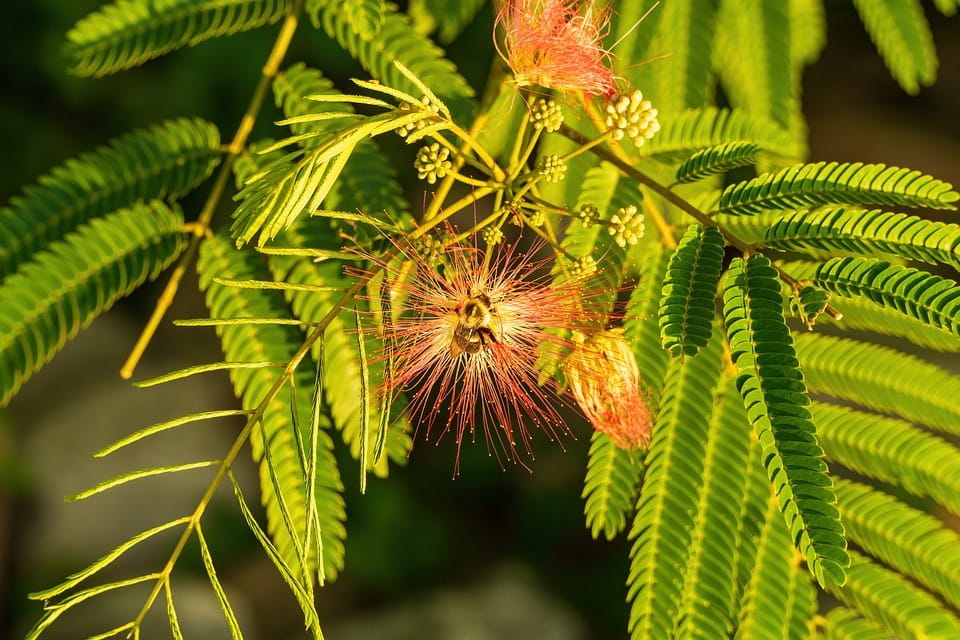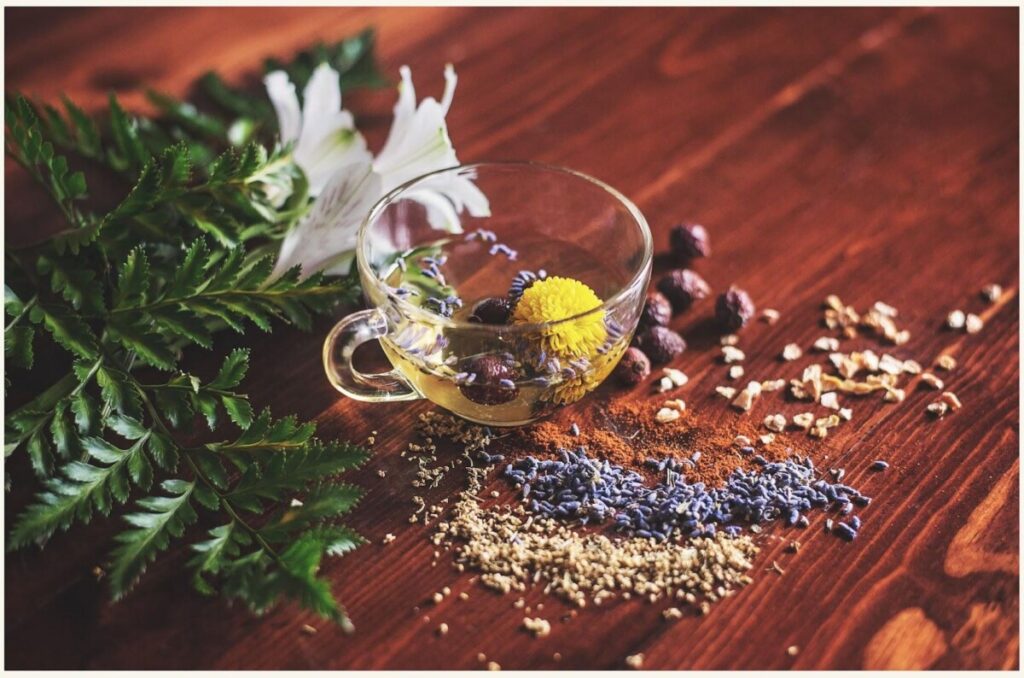Mimosa hostilis is known as just an hallucinogen drug, but it has many benefits and uses beyond that. Its incredible properties have been explored through the ages, and in this article we want to show you why this herb is useful for a lot of different reasons.
Mimosa hostilis, also known as Mimosa tenuiflora, is a perennial tree that is native to the northeastern region of Brazil and has been in the public eye for a while due to its potent psychotropic properties. This plant’s root bark is one of Ayahuasca’s main ingredients, a shamanistic brew with intensely powerful hallucinogenic properties.
Its root bark is also used to extract DMT, a very popular hallucinogen. This plant also has immense entheogenic uses, especially in the Jeruma Cult. When Mimosa hostilis root bark powder is brewed into a drink, it is claimed to have mind-healing properties that help users get past trauma, achieve enlightenment, and overcome depression.
However, there’s so much more to know about this plant, let’s have a look together with Dr. Claudio Butticè, Pharm.D., an expert in pharmacology and herbal medicine.
What is Mimosa Hostilis?
Mimosa hostilis belongs to the Mimosoideae family, a group of legumes (Fabaceae) just like the common peas and beans you bring to your table. The whole genus includes at least 25 species, and should not be confused with the mimosa tree that, albeit being a Fabacea as well, it is not a member of the Mimosoideae family, but rather an Acacia tree. The name “mimosa” originates from the greek “mimos” which means “mime”, to describe the unique peculiarity of its leaves that fold and close when touched like they’re “mimicking conscious life”.
The Mimosa species can be found thorough Asia, from India to China and Japan, as well as in North and Central America. Unlike the acacia tree, flowers are prickly and pink, or somethimes white, and the fruits are shaped like small lances. They’re beautiful enough for the plant to be used for ornamental purposes. Individual plants grow wild on all kind of terrains such as hillsides, walkways and roadsides, often forming dense aggregations especially when the soil is particularly wet, such as on the margin of rivers and lakes or marshes.
Now, let’s have a look at the incredible, and often unknown properties of this traditional medicinal herb.

1. Tremendous Traditional and Historical Value
This plant has been around for ages and has been used for many things over the years. Mimosa tenuiflora is a staple of natural medicine in its native Brazil and Mexico, much before the Portuguese colonized these territories. It’s known by several names, the most popular of which are Tepezcohuite, Jurema (or Yurema), Carbonal, Calumbi and Cabrera. Jurema wine (often called “anjucá” or “ajucá”) was made by the Truka, Pankararu, Atikum and Kambiwa tribes as an hallucinogen drink that served many ritual, healing and social purposes for these people.
Considered a sacred plant, it had a significant religious and traditional importance, and, to be harvested, it could be touched only by the tribe’s oldest and wisest member who received a proper initiation. The bark and root of the plant would then be cooked for a long time in a special clay pot, while a ritual involving candles and tobacco was performed. In particular, the ritual was practiced during the Toré festival, in which mythical ancestors were worshipped through songs and rites. In other regions of Brazil and Africa, it was also used for construction purposes, such as to build fences to protect crops and animals, as well as a tool or as fuel.
M. hostilis has a rich history as a popular entheogenic and is used even today due to its many benefits, ranging from healing to psychedelic properties. According to folklore medicine, it could be used for the treatment of many different ailments ranging from simple colds and superficial wounds, to eye problems, gastrointestinal disorders, urinary conditions, and even to stop bleeding. Several of these effects have been later been proved scientifically, including some less known ones such as its ability to reduce pain. Mimosa may have an interesting antinociceptive potential that could be linked with less known antioxidant and anti-inflammatory properties.
2. Regenerative, Wound Healing and Anti-Bleeding Effects
Mimosa hostilis root bark powder has a very high tannin (proanthocyanidins) content, making it a very popular all-natural blood coagulant. The tannins themselves act as an astringent, a chemical that shrinks and constricts body tissues. That, in turn, stops bleeding and promotes healing and the development of new tissue.
Even today, in the countryland of Chiapas, some indigenous communities from Ocozocoautla and Cintalapa boil the bark or stem of the plant to prepare a thick poultice that could be placed on the wound. Other communities from Oaxaca, instead, boil it until nearly all water is evaporated, and use the remaining infusion to ease burns and bleeds.
Mimosa has been used by many tribes as a remedy for “woman problems”, and while this application may stem from its antinflammatory properties, it may be argued that it was also due to its coagulant properties. Tannins can help reduce excessive menstrual bleeding, and their astringent properties can also ease itching and discomfort.
3. Powerful Hallucinogenic Properties
The root bark of the Mimosa tenuiflora tree has quite a significant 5-hydroxy-tryptamine, and N,N-dimetyltryptamine (DMT) content. DMT is one of the most popular psychedelics, and the main active ingredient of Ayahuasca, a shamanistic psychedelic brew traditionally used to help users recover from trauma, depression, and even severe mental illnesses such as PTSD. When ingested, DMT alone is normally unable to exert any hallucinogenic effects since it is rapidly destroyed by the action of monoamino oxidases (MAO), natural enzymes found in our bodies. It has been suggested that mimosa extracts contain MAO-inhibitors that could regulate the absorption of DMT, inducing a slow and very tolerable hallucinogenic experience that is often perceived as pleasant, unlike other stronger substances such as lysergic acid diethylamide (LSD).
However, the visionary effects extracts of mimosa may be due to more than just DMT, as other substances such as Yuremamine have been found to possess psychotropic properties as well. It is possible that the complex extraction process performed during the religious rites practiced by many indigenous populations, may serve the purpose of extracting more of these alkaloids, other than being merely ritualistic.

Overall, the psychogenic experience of Mimosa hostilis is described as an entactogenic one in nature, meaning that it promotes a feeling of oneness, emotional peace, fullness and communion with the world, nature, and the others we love. After a first stage of hollow headed, slight confusion and drowsiness, senses such as sight and hearing become sharpened and the psychonaut feels a deep silence that bring inner peace and happiness. Hallucinations may become visions, and a true journey towards personal completeness and fulfillment will then begin.
4. It’s a Delicious and Healthy Food
We’ve stated before that this plant’s root bark extract is consumed for many reasons, but it’s arguably very delicious. Unlike with other natural psychedelics that are so hard to stomach, Mimosa hostilis root bark powder has a good taste when you eat or drink it. It usually doesn’t cause nausea or vomiting, and it even has some recipes – the most popular of which is brewing it with other ingredients such as lemon juice and honey for a tasty drink.
In fact, mimosa has been used for centuries to treat many gastrointestinal ailments such as constipation, diarrhea, and heartburn. The reason why it may exert such a broad range of effects on both the gastric and intestinal tissues, may be due to different but synergistic properties. On one hand, its regenerative and antiseptic properties may accelerate recovery in case of stomach or duodenal ulcerations. On the other, it has observed that mimosa could relax intestinal smooth muscles while increasing the tonus of stomach walls at the same time. This will help improve digestion, all while reducing spasms and abnormal peristaltic reflexes that characterize, for example irritable bowels.
5. Antifungal, Antibiotic, Antimicrobial, and Anti-inflammatory Properties
This plant’s healing properties have been known for centuries, and it has been used for a broad range of uses such as cuts, wounds, burns, and bleedings. Besides its regenerative properties described earlier on, the mimosa plant also possesses anti-inflammatory properties and can act as a natural antibiotic. All these properties work alongside each other to prevent infections while promoting healing.
In a very peculiar experiment, mimosa extracts have been successfully used to treat poisoning from scorpion venom (one of its many folkloristic uses). Interestingly enough, the treatment with this herb’s extracts lead to a significant reduction in a series of substances with inflammatory effect known as cytokines, as well as a reduction in migration of those cells responsible for excess inflammation reactions. This experiment may, therefore, explain why mimosa is so effective in reducing inflammation only when a damaging substance or agent is causing the body to overreact.
Additionally, Mimosa hostilis bark powder has excellent antifungal and antimicrobial properties, which make it less likely for wounds to get infected since it hampers harmful fungi and bacteria from colonizing tissues. That’s why this plant is used as the main ingredient in a range of health products, such as skin creams for acne as well as dermatologic and hair loss prevention products for other skin conditionssuch as eczema, psoriasis and herpes. Aside from creams, the Tepezcohuite made with Mimosa tenuiflora is used for treating stomach illnesses, vaginitis, and fungal infections on the skin.

6. High Dermatologic and Cosmetic Value
The healing and psychedelic properties of this plant aren’t the only things that make Mimosa Hostilis as accessible as it is. The plant is also one of the main ingredients in a wide range of beauty, cosmetic, and wellness products such as soaps, shampoos, lotions, and many more. One of the reasons behind this may be its inherent antibacterial activity that we discussed above. Since mimosa can kill bacteria and other microorganisms such as fungi, it may help keep the skin clean, regulate the production of sebum and prevent conditions such as acne, seborrheic dermatitis and dandruff.
However, the dermatologic properties of mimosa may also be attributed to the presence of several saponins, such as mimonoside A, mimonoside B, and mimonoside C, polysaccharides, as well as triterpenoids such as lupeol. These substances may promote cellular proliferation, in particular of dermal fibroblasts and keratinocytes, two types of cell that are critical to the health of our skin. This effect will lead to the regeneration of damaged tissues, skin rejuvenation, and together with its antioxidant properties, it may help keep the skin young by protecting it from stressors such as weather, pollution, aggressive soaps, etc.
Today, bark extracts have been used with positive results in the treatment of venous leg ulcerations. These effects may be due to the synergistic of different active compounds that leverage its regenerative effects, the astringent and coagulative properties of tannins, and its antinflammatory and antioxidant abilities. Its antimicrobial power may also help keep the ulceration wounds clean and disinfected, promoting tissue healing and speeding up recovery.
7. Dye Properties
Mimosa hostilis root bark powder has immense value as a dye, as it produces excellent shades of purples, indigo and browns. Thanks to the high content in tannins, pigments are vibrant, which makes it a superb textile dye that provides consistent results that last for a lifetime.
Depending on the dye itself, the amount you use, and the method of dying – using Mimosa hostilis root bark powder can give you different shades from light reds to rich purples, and everything in between. The longer the powder is left to boil in the water, and the longer is the textile left soaked in that water, the stronger will be the intensity of the shading. Mimosa root bark can be used to dye either textiles or tan leather.
Final Thoughts
Mimosa tenuiflora is one of the best naturally occurring psychedelics out there with some immense health benefits – and is a staple of natural medicine. Beware, though, not only Mimosa hostilis may not be legal to use and consume in your state since it has hallucinogenic properties, but it may also be harmful to your health if not consumed in the right way or if you suffer from certain conditions. You should always seek your doctor’s advice before using it to avoid unnecessary risks and dangers.
However, Mimosa hostilis root bark powder isn’t only an all-natural health giant, as it’s used for dyes. Purchasing the whole bark is legal, as it is not a controlled substance. This won’t mean you should do without caution, though. In fact, if you want to explore its many health benefits for your body, always do that responsibly!
About the author:

Dr. Claudio Butticè, Pharm.D., is a former Pharmacy Director who worked for several large public hospitals in Southern Italy, as well as for the humanitarian NGO Emergency. He is now an accomplished book author who has written on topics such as medicine, technology, world poverty, human rights, and science for publishers such as SAGE Publishing, Bloomsbury Publishing, and Mission Bell Media. His latest books are “Universal Health Care” (2019) and “What You Need to Know about Headaches” (2022). A data analyst and freelance journalist as well, many of his articles have been published in magazines such as Cracked, The Elephant, Digital Journal, The Ring of Fire, and Business Insider. Dr. Butticè also published pharmacology and psychology papers on several clinical journals, and works as a medical consultant and advisor for many companies across the globe.
References
- Hamill, J. et al. (2019) ‘Ayahuasca: Psychological and physiologic effects, pharmacology and potential uses in addiction and mental illness’, Current Neuropharmacology, 17(2), pp. 108–128. doi:10.2174/1570159×16666180125095902.
- Majeed, I. et al. (2021) ‘A comprehensive review of the ethnotraditional uses and biological and pharmacological potential of the genus mimosa’, International Journal of Molecular Sciences, 22(14), p. 7463. doi:10.3390/ijms22147463.
- Amariz, I.A. et al. (2020) ‘Chemical Study of mimosa tenuiflora barks’, Natural Product Research, 36(7), pp. 1893–1897. doi:10.1080/14786419.2020.1813135.
- Magalhães, F.E. et al. (2018) ‘Orofacial antinociceptive effect of mimosa tenuiflora (Willd.) poiret’, Biomedicine & Pharmacotherapy, 97, pp. 1575–1585. doi:10.1016/j.biopha.2017.11.001.
- Ferreira, T.L. and Evangelista, A.J. (2021) ‘Mimosa tenuiflora’s antimicrobial activity on bacteria and fungi from medical importance: An integrative review’, Archives of Microbiology, 203(6), pp. 3399–3406. doi:10.1007/s00203-021-02330-6.
- Bitencourt, M.A. et al. (2014) ‘Neutralizing effects of mimosa tenuiflora extracts against inflammation caused by tityus serrulatus scorpion venom’, BioMed Research International, 2014, pp. 1–8. doi:10.1155/2014/378235.
- Rivera-Arce A et al (2007) Therapeutic effectiveness of a Mimosa tenuiflora cortex extract in venous leg ulceration treatment. J Ethnopharm 109:523-528
- Erkan G., Şengül K., Kaya S. Dyeing of white and indigo dyed cotton fabrics with Mimosa tenuiflora extract. J. Saudi Chem.Soc. 2014;18:139–148. doi: 10.1016/j.jscs.2011.06.001.
Frequently Asked Questions (FAQs)
What is Mimosa Hostilis and where is it found?
Mimosa Hostilis, also known as Mimosa tenuiflora, is a perennial tree native to the northeastern region of Brazil. It belongs to the Mimosoideae family, which includes various legumes. This plant can also be found in other regions of the world, including Asia and North and Central America.
What are the traditional and historical uses of Mimosa Hostilis?
Mimosa Hostilis has a rich history of traditional and historical uses. It has been used for centuries in natural medicine by indigenous tribes in Brazil and Mexico. The plant’s root bark has been utilized for various purposes such as ritualistic hallucinogenic brews, wound healing, and treatment of gastrointestinal disorders, among others.
What are some of the health benefits associated with Mimosa Hostilis?
Mimosa Hostilis offers several health benefits, including wound healing, regenerative effects, anti-bleeding properties, and antimicrobial, anti-inflammatory, and antifungal properties. Additionally, its root bark contains compounds with hallucinogenic properties, which have been used in shamanistic practices for psychological healing.
How does Mimosa Hostilis contribute to wound healing and what are its regenerative effects?
Mimosa Hostilis root bark powder contains high levels of tannins, which act as astringents and promote wound healing by shrinking and constricting body tissues. These properties help stop bleeding and stimulate the development of new tissue. Additionally, Mimosa Hostilis has regenerative effects on the skin and may aid in treating various dermatologic conditions.
Are there any precautions or considerations one should take before using Mimosa Hostilis for its health benefits?
Before using Mimosa Hostilis for its health benefits, it’s essential to consider potential legal restrictions and health risks. While the plant is legal in some areas, it may have hallucinogenic properties and could be harmful if consumed incorrectly or by individuals with certain health conditions. Seeking advice from a healthcare professional is advisable before use to mitigate potential risks.
Article published on July 24, 2020 and updated on March 19, 2024